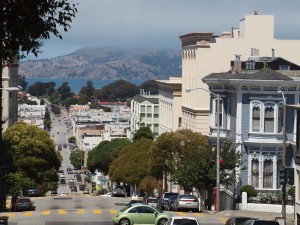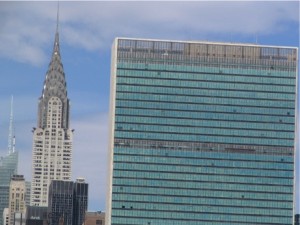
Greenbuild was held in San Francisco this year. Here, an image of the Bay from Pacific Heights in San Francisco.
Yesterday I saw the sun rise over the Pacific Ocean and set over the Atlantic Ocean. I’ve probably witnessed that many times in my life and never noticed it. Today, for some reason, it astonished me and I was in awe over the capacity of our technology to open up the world to us. Flying cross-country for 36 hours seems wasteful from a carbon standpoint. But the chance to do that so I could attend and speak at the Greenbuild International Summit in San Francisco one day and then attend a memorial service for a dear friend in New York City the next made it all worthwhile. My carbon guilt was somewhat assuaged when I opened the USAirways Magazine and read a letter from the President describing their green efforts, many of which are quite impressive. And then for the first time on a plane, the flight attendants were collecting recycling.
The Greenbuild International Summit
The 6th Annual Greenbuild International Summit was held this past Tuesday, November 13th, 2012. Typically held the day before Greenbuild proper begins, it is described as “the place for international green building conversations, and a place to learn about innovative strategies and green building policies and programs being implemented around the world.” It was my first Summit and everyone declared it was the largest (450 people) and the most comprehensive. I was honored to have been invited by Rick Fedrizzi, USGBC’s President and CEO, to facilitate and speak at the final plenary – “LEED and International Historic Restoration.” I found the entire day inspiring from both informational and networking standpoints, and it reminded me that although we are a large and diverse world we are all connected by our desire to save it.
Existing Buildings Are On Everyone’s Minds
Every single speaker mentioned or acknowledged that the performance and operations of existing buildings is crucial to managing climate change, although few dug deeper into their real significance until the end of the day. But I was delighted to at least know that it is on everyone’s minds now if not in their actual practices yet.
Leadership, Partnerships and Smart Design in Green Buildings – Opening Plenary

The Governor of Brasilia presented the greening of his midcentury modern iconic city to the International Summit participants and gave everyone this beautiful book.
Rick Fedrizzi reported that there are now 89 members of the World Green Building Council. John Mandyck, Chief Sustainability Officer for Carrier proclaimed that green buildings are no longer just trophies or aspirational; people now demand green buildings in 40% of all commercial construction. The Australian Green Building Council has become one of the largest with 55 staff while its counterpart, the Australian Institute of Architects, has 12,000 members and is growing. In Australia they are primarily using a rating system called GreenStar, which is a counterpart to LEED.
Both organizations have partnered to create an annual summit at their federal government center in Canberra called BEMP, the Built Environment Meets Parliament, which sounds like one of our lobbying days, but more structured and potentially productive.
Robert Ivy, CEO and Executive Vice-President of our AIA, proclaimed that climate change is real! We got that message loud and clear from Hurricane Sandy last week. The AIA’s 2030 commitment is focusing on the improved performance of buildings, and that means existing buildings are key. The AIA’s partnerships with other like-minded organizations are what is making the organization more relevant and important. Partnerships with the National Institute of Building Sciences and the Clinton Climate Initiative are developing peer reviewed sustainability research programs. We should always be asking ourselves, “What are we going to do next?”
Elizabeth Heider, current Chair of the USGBC Board and a Senior Vice President at Skanska USA, shared her thoughts that good green buildings provide us with enduring beauty, actual performance, transparency, health and wellness, positive indoor environmental quality and resiliency. A goal for all us should be to push our field and government to require Health Product Declarations (HPDs), like many of the European countries already do. Having the AIA Contract Documents, which rule the construction field in the US, start to incorporate HPDs into their language would be a significant beginning.
New Priorities and Accomplishments of the LEED International Roundtable – Breakout Panel
The LEED International Round Table, which functions as an executive committee for the World Green Building Council, now includes 21 countries. Alfonso Ponce from Deloitte began the session by showing us that LEED is less and less American. And I liked hearing that. One of my fears with the move to do everything locally is that that could backfire and we could all end up becoming isolationists and hermits! As LEED listens and reflects to other cultures it can only become richer. Cristina Gambon from the Columbia Green Building Council informed us how important her country is to the biodiversity of the world – it’s one of the five most biodiverse countries in the world and seventh in terms of fresh water abundance.

Cartagena, Colombia. Colombia is one of the most biodiverse countries in the world. Photo courtesy Wikipedia.
Bengt Wanggren, the CEO of the Sweden Green Building Council,presented their efforts to incorporate Regional Priority Credits into LEED. They are the fastest growing environmental organization in Sweden. Swedish projects currently use one or any combination of four rating systems – LEED, EU Green Building, Miljobyggnad, the (Swedish rating system) or BREEAM. LEED tends to be used on the high profile and/or internationally based projects. They currently have 100 LEED projects in process, 22 are certified and 27% of these 100 either are already or are targeting LEED Platinum certification.
Before 2010, regional priority credits were not allowed outside of the US. In 2012 the Roundtable identified their own regional priorities, which were initiated at the Nordic Green Building Conference Workshop. The six credits ultimately approved by USGBC are 1) Site Development, Protect or Restore Open Space, 2) Water use reduction, 3) Daylight for 75% of spaces, 4) Optimize energy performance (only 1 point), 5) Public Transportation Access and 6) Renewable Energy (which is a EU priority). These credits have been adopted by both Sweden and Norway. Their goal is to use these regional credits to advocate for improvement to standard practices.
The New Dimension: $3.5 Trillion Fueling Global Green Buildings – Luncheon Plenary
This session provided insight into how some of the world’s largest real estate investors are integrating sustainability in their real estate investments. Geraud Denis, President and CEO of United Technologies Climate, Controls and Security identified the announcement in 2003 by GSA that all their new and major rehabilitation projects were required to achieve LEED Silver as an “arc for transformation” for LEED. Today we stand at an inflection point with 47,000 projects now registered for LEED certification world-wide. He finished by reporting that the greatest opportunity in green building exists within the retrofits of existing buildings. Efficiency and financial payback from green retrofits are now received as follows: 43% payback in less than five years and 85% in less than ten years.
Much of the discussion of this panel, by representatives from some of the largest real estate and investment companies in the world, revolved around the fact that green building is now a sustainable and productive investment. Nils Kok, a professor at both UC Berkeley and Maastricht, as well as the co-founder of the Global Real Estate Sustainability Benchmark (GRESB), shared that there is now convincing evidence that there is financial benefit to investors in rents and occupancy with green buildings. David DeBos, Vice President, Global Director of Sustainability at Prudential Real Estate Investors reported that Prudential took seriously the UN Sponsored Principles for Responsible Investment (PRI) and as one of the 1100 investors to sign on, is using this to guide their transactions.

Tishman Speyer’s art deco skyscraper, the Chrysler Building, became the latest New York City icon to achieve LEED Gold EB:O&M certification last month.
Andrew McAllan, Senior Vice President & Managing Director, Real Estate Management, at Oxford Properties, a Canadian company, created a “Sustainable Intelligence Team” after visiting the construction of the new Bank of America’s LEED Platinum headquarters in New York City in 2004. They achieved their goal to reduce greenhouse gas emissions prior to their 2012 target. Sander Paul van Tongeren, Senior Sustainability Special at APT Asset Management, reiterated the findings of his colleagues that green building was good investment business. And finally, Jonathan Flaherty, Director of Sustainability at Tishman Speyer delighted the audience (or at least me!) by telling us that the Chrysler Building received LEED Gold EB:O&M Certification three weeks ago.
Brasilia and World Green Building Trends
One of the treats of the day was a special presentation by the Governor of Brasilia, His Excellency Agnelo Quierioz. The green economy and sustainable construction in Brazil are growing exponentially and their adoption of LEED is helping to spur this. With both the World Cup (2014) and the Olympics (2016) coming to Brazil, regional governments have incentivized green buildings and infrastructure in their cities. Quierioz, a physician by training, is one of the stars in the South American sustainability world and the rigor with which Brasilia has adopted their sustainability efforts shows this. All new buildings and stadia are targeting LEED platinum, while reflecting the glory of the innovative design that is the wonder of Oscar Niemeyer’s Brasilia (the capital of Brazil). The Brazilian delegation brought gorgeous coffee table books on Brasilia for all attendees, which this midcentury modern aficionado is quite grateful for!

Retrofit of historic and existing buildings in Europe accounts for upwards of 60% of the green construction in countries like Italy and the UK. For example, this former city hall in Noto, Sicily has been adapted as an entertainment center.
Harvey Bernstein, Vice President of Industry Insights & Alliances at McGraw-Hill Construction shared the World Green Building Trends Report, which was just published in summary form this week. (The full report will be published online the first quarter of 2013). The two key findings were: 1.) Green building has become a long-term business opportunity with 51% percent of study firms planning more than 60 % of their work to be green by 2015, up from 28 percent of firms in 2012, and 2.) the largest opportunity areas for green building globally are in new commercial construction and renovation of existing buildings. Green retrofits and renovation in Europe and the US comprise upwards of 50% of the green building in those countries, with the UK exceeding 60%! It’s great to see the data starting to prove what we’ve anecdotally known for years, now if we could only get the media to pick up on it too and not just report on the glitzy new green buildings (and I love glitzy new green buildings too, but come on, let’s see some balance!)
Italians Suggest a New Historic Resources Category for LEED – Closing Plenary
In my own closing panel “LEED and International Historic Restoration”, the Green Building Council of Italia (Italy) recommended a new protocol for historic buildings. And that’s a teaser for my next blog!
And if you’d like to “subscribe” or follow my blog, True Green Cities, please sign up through the “Subscribe” button at the bottom left of this page. You’ll receive a daily recap when new blogs are posted. Or Sign up for the Feed.
